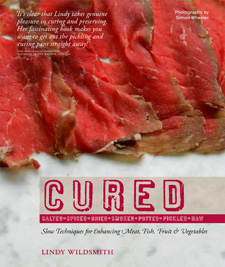Recipe
November 8, 2010
Home-Cured Ham Recipe

Step 1: Put half the liquid in a large saucepan with the remaining ingredients and bring gently to the boil. Simmer until the salt and sugar has dissolved.
Step 2: Leave to cool and then stir in the rest of the liquid. Stab the ham all over with a sharp knife or skewer to the very centre of the meat. Fill the pump with brine and inject the brine into the thickest parts of the ham, in and around the bone.
Step 3: Put the ham in a large, non-corrosive container and add the cooled brine to cover. Put a weight over the meat to ensure that it is completely immersed. If the ham is not completely immersed, you will need to make extra brine. Put the container in the fridge, cool larder or a cold cellar and leave for 3 weeks.
Step 4: After that time, remove the ham from the brine, rinse and drain, wipe and dry it, then hang in a refrigerated room or meat safe. Alternatively, wrap in muslin or immerse in a solution of lard and black pepper, then hang in a cool, airy cellar or outhouse for 1 month. Either roast or boil the ham to serve.
Reprinted with permission from Lindy Wildsmith’s Cured (2010 Jacqui Small).

Directions
Yield:
Step 1: Put half the liquid in a large saucepan with the remaining ingredients and bring gently to the boil. Simmer until the salt and sugar has dissolved.
Step 2: Leave to cool and then stir in the rest of the liquid. Stab the ham all over with a sharp knife or skewer to the very centre of the meat. Fill the pump with brine and inject the brine into the thickest parts of the ham, in and around the bone.
Step 3: Put the ham in a large, non-corrosive container and add the cooled brine to cover. Put a weight over the meat to ensure that it is completely immersed. If the ham is not completely immersed, you will need to make extra brine. Put the container in the fridge, cool larder or a cold cellar and leave for 3 weeks.
Step 4: After that time, remove the ham from the brine, rinse and drain, wipe and dry it, then hang in a refrigerated room or meat safe. Alternatively, wrap in muslin or immerse in a solution of lard and black pepper, then hang in a cool, airy cellar or outhouse for 1 month. Either roast or boil the ham to serve.
Reprinted with permission from Lindy Wildsmith’s Cured (2010 Jacqui Small).


